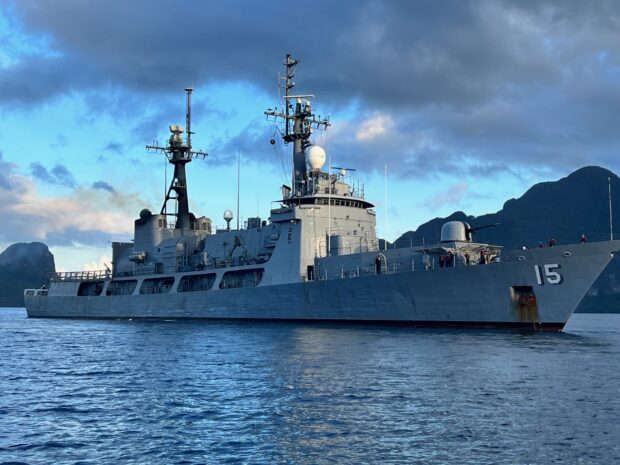No holiday for PH ship guarding country’s waters

READY FOR NEXT MISSION The BRP Gregorio del Pilar anchors off El Nido, Palawan, on New Year’s Day. —FRANCES MANGOSING
ABOARD THE BRP GREGORIO DEL PILAR, West Philippine Sea—The BRP Gregorio del Pilar (PS-15) was steaming in the middle of a vast, dark ocean, a few hours away from its destination in El Nido, Palawan, when the clock struck midnight on New Year’s Eve. The crew were far away not just from their loved ones, but also from the festivities on land.
The patrol ship had just wrapped up successful sea trials off Subic on Dec. 30 and was on its way back to port when it received sudden orders to take part in a three-day “maritime cooperative activity” (MCA) between the Philippines and the United States from Jan. 2 to 4 in the West Philippine Sea. But first, it had to sail to El Nido to pick up Navy guests and a handful of journalists, including the Inquirer, who would observe the drills.
By sunrise of Jan. 1, the Del Pilar was anchored off El Nido for its first mission and left again at lunch for the exercises off Occidental Mindoro.
Four Philippine Navy ships were originally tasked to participate in the MCA: Aside from the Del Pilar, there was the BRP Davao del Sur (LD-602), which also departed from El Nido; the BRP Ramon Alcaraz (PS-16), which came from Subic; and the BRP Jose Rizal (FF-150), which was supposed to join much later after a passing exercise with the Korean Navy off Manila Bay.
The rest of the first day of the year was uneventful for the Navy and journalists onboard the Del Pilar. There was more time to bond with each other after cell phones went dead as the ship sailed farther from land. Access to the internet on board was limited to military communication.
Article continues after this advertisementUnexpected delay
The next morning, reporters gathered early to observe the first day of the MCA, only to learn that the US side had asked for a one-day delay due to “operational requirements.” Both navies were supposed to sail in formation for a photo exercise and hold joint patrols, among other activities.
Article continues after this advertisementThe maritime exercise, the second since November, was designed to enhance interoperability as the two allies step up cooperation amid China’s growing aggressiveness in the South China Sea.
“Maybe we should stop over at the nearest island and go snorkeling first,” Western Command chief Vice Adm. Alberto Carlos, who oversees Palawan and the Kalayaan Island Group, said in jest. He wanted to witness the drills himself.
The Del Pilar spent the next hours patrolling the Malampaya gas platform and other parts of the West Philippine Sea before heading to the exercise venue for the next day.
On Jan. 3, the US Navy destroyer USS Sterett (DDG-104), one of the escort ships of the nuclear-powered aircraft carrier USS Carl Vinson (CVN-70), showed up. Two other US warships and the Carl Vinson were nowhere to be seen, even on the radar, with the US side explaining that this was due to “operational necessity.”
Some of the supposed highlights for that day’s activities were replenishment at sea and firing of naval guns by both countries. Instead, the Philippine ships briefly patrolled with the Sterett, although the US ship was at least 7.4 kilometers (4 nautical miles) away nearly the entire time. The BRP Rizal no longer joined the MCA after its engagement with the Korean Navy.
“Unfortunately, they (US side) did not give specifics [on why the other activities were canceled]. They just said that ‘due to some operational necessity,’ they have to reallocate some of their forces to other tasks,” Carlos said.
Still, he called the exercise “a good training opportunity for both forces,” adding that, “we adjust our operations based on the operational condition on the ground.”
Shadowing
Throughout the joint activity, the Philippine and US ships were shadowed by Chinese warships—a Jiangkai-class frigate and a Luoyang-class destroyer. “We challenged them, but they said they [were] operating within their jurisdictional area—which [was] false,” Carlos said. The Philippine ships were around 148 km (80 nautical miles) from land during the exercise.
By Jan. 4, the last day of the MCA, more American ships were present. Philippine Navy choppers from the Del Pilar and Alcaraz ferried Carlos and other officials to the aircraft carrier USS Carl Vinson for short talks and to witness flight deck operations. American fighter jets took off from the landing deck, as the Chinese warships became more persistent in shadowing.
They weren’t hostile compared to their coast guard counterparts. Filipino and American ships also exchanged radio messages with the Chinese to remain at a safe distance.
After the Philippine officials returned from the Vinson, the Del Pilar started making its way to El Nido to drop off its guests.
On board the ship manned by a 138-strong crew that worked five-hour shifts twice a day, the atmosphere started to relax.
The 3,300-ton Del Pilar has been operating for more than five decades, 44 of those years under the US Coast Guard.
Cmdr. Alan Sonon, the commanding officer of the ship deployed to the Western Command covering the West Philippine Sea, is a second-generation defender of the country’s maritime interests. His father, a retired navy officer, once served on the BRP Sierra Madre before it was grounded on Ayungin (Second Thomas) Shoal and turned into a military outpost.
Maritime operations do not cease on holidays or special occasions, Sonon said. “We need to sustain our presence here,” he added. “If we don’t show up and neglect our duties to keep guard on these waters, it weakens our claim.”
For comprehensive coverage, in-depth analysis, visit our special page for West Philippine Sea updates. Stay informed with articles, videos, and expert opinions.